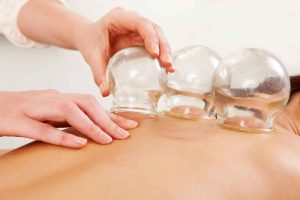 The most recent Olympic Games brought a lot of attention to three health practices: kinesio tape for sore muscles, cupping therapy, and ice baths. How much science is behind these flashy, in-the-news athletic techniques?
The most recent Olympic Games brought a lot of attention to three health practices: kinesio tape for sore muscles, cupping therapy, and ice baths. How much science is behind these flashy, in-the-news athletic techniques?
There are two things to keep in mind about health fads and trends. Most of them aren’t really new at all, and just because a famous athlete uses something does not mean it is effective or safe.
What is Kinesio Tape, and Does it ‘Work’?
Kinesio tape was impossible to miss at the Rio Olympic Games. Runners, wrestlers, swimmers, gymnasts and dozens of other kind s of athletes wore the brightly colored tape on arms, legs, ankles, fingers, and feet. For many viewers, the tape was a mysterious addition to otherwise ancient sporting activities.
s of athletes wore the brightly colored tape on arms, legs, ankles, fingers, and feet. For many viewers, the tape was a mysterious addition to otherwise ancient sporting activities.
While kinesio tape is, technically speaking, relatively new, various forms of body taping and wrapping has been around for a very long time. Kenzo Kasa, a chiropractor from Japan, came up with the idea of the colorful tape about 40 years ago as a way to aide muscle relaxation, speed up rehabilitation, cut down on pain, and to reduce or avoid inflammation.
The tape has been the subject of many studies, all of which conclude that there is no verifiable benefit to using it. Putting tape on the skin can’t, according to the research, have any significant effect on how the muscles perform or recover. Most experts now believe that kinesio tape’s apparent benefits are primarily psychological rather than physical.
Some athletes have found that supporting the musculature during or after a strenuous event brings actual physical relief, though those results are hard to prove in a laboratory. In addition, the only difference between kinesio tape and other body wraps is the color. Some psychologists believe that the loud colors are a sort of “announcement” by the wearer that a particular body part is problematic.
If athletes truly believe that kinesio or other body tapes can help them perform better then there could be a significant placebo effect from using the product. Can kinesio tape be harmful in any way? Probably not, according to those who have studied it, unless a user wraps it so tightly as to impede proper circulation.
The verdict on kinesio tape is that it can help to bolster the attitude of those who use it, and it likely doesn’t have any ill effects. But as for measurable physical benefits, research hasn’t discovered any.
Do Ice Baths Reduce Muscle Soreness?
 Another practice that got a lot of air time at the Olympics was cold water immersion. Commonly called ice baths, competitive athletes take the frigid dips immediately after a strenuous practice or match in order to relieve muscle soreness. Some also claim that ice baths speed up recovery time and decrease inflammation.
Another practice that got a lot of air time at the Olympics was cold water immersion. Commonly called ice baths, competitive athletes take the frigid dips immediately after a strenuous practice or match in order to relieve muscle soreness. Some also claim that ice baths speed up recovery time and decrease inflammation.
Unlike the situation with kinesio tape, ice baths have undergone rigorous scientific study. Compared with doing nothing after a strenuous workout, ice baths can reduce immediate and delayed muscle soreness by about 20 percent. But, so can massage, ibuprofen, walking and stretching.
There is even evidence that athletes in ancient times used very cold and very hot water therapy to alleviate pain. Modern ice baths use water that is between 50 and 59 degrees. Users typically stay in the bath for about 15 minutes (or however long they can stand it!), and immerse themselves up to their waists. Many report immediate relief from pain, while others claim that a post-exercise immersion can also prevent delayed-onset soreness, a type of muscle pain that arrives a day or two after a strenuous bout of exertion.
One note of caution for those contemplating an icy plunge in cold water: low temperatures on the skin can be quite a shock to the bloodstream, and could cause some problems for people with blood-related, or blood pressure control afflictions. In fairness, however, that same can be said for massage and medications, so it’s definitely best to consult a doctor before becoming an adherent of any pain-reduction regimen, even conventional ones.
Ice baths should not be confused with the therapeutic technique of placing ice-cold compresses directly onto body parts for medical purposes. Those temperatures are much lower, sometimes as much as 25 degrees lower, than ice bath therapy.
Does Cupping Help With Pain and Inflammation?
 Cupping became an overnight international sensation when one of the world’s most famous athletes, and multi-gold medal Olympian, Michael Phelps displayed the obvious markings of having undergone extensive cupping therapy. Because the ancient practice uses light suction cups on the skin, people end up with about a half-dozen red circles on their bodies after the cups are removed at the end of a session. TV announcers went into detail about Phelps’s red marks because so many viewers were expressing concern and wondering how the famous swimmer came to look like a two-legged Dalmatian.
Cupping became an overnight international sensation when one of the world’s most famous athletes, and multi-gold medal Olympian, Michael Phelps displayed the obvious markings of having undergone extensive cupping therapy. Because the ancient practice uses light suction cups on the skin, people end up with about a half-dozen red circles on their bodies after the cups are removed at the end of a session. TV announcers went into detail about Phelps’s red marks because so many viewers were expressing concern and wondering how the famous swimmer came to look like a two-legged Dalmatian.
Cupping is said to have all sorts of medical benefits, from pain reduction to overall relaxation. In fact, more than 3,000 years ago people in China, Egypt and the Middle East used cupping as a standard medical practice. Some modern variations of cupping include “bleeding” the suctioned skin with scalpel cuts to remove impurities from the bloodstream.
There has been some research pointing to the effectiveness of cupping for various maladies like shingles, facial paralysis, and acne. There is even a British Cupping Society, an organization of professionals who use and advocate the practice. Anyone considering the therapy should talk with a doctor first, though cupping is relatively safe if performed by a professional.
The British Cupping Society notes that there are many other ailments that suction therapy can treat besides acne and shingles, including eczema, migraine headaches, general anxiety, high blood pressure, varicose veins, and some forms of rheumatic diseases and certain blood disorders.
The possible side effects of cupping can include burns on the skin (depending on the type of suction used), mild physical discomfort, bruising, and infected skin. These side effects rarely occur when the health care provider is a licensed professional.
Modern believers in the practice of cupping say that it helps reduce post-event pain and inflammation, while also bringing on a psychological feeling of well-being and relaxation. The alleged results of cupping are quite similar to the documented effects of deep-tissue massage, another ancient form of bodywork.
Are Cold Baths, Colorful Tape and Suction Cups the Way to Go?
All three of the alternative health practices above are relatively safe, even if there is not a huge amount of evidence to prove their effectiveness. Cupping, however, is something to be really careful with as it can cause infections in some who use it. Ice baths can also have adverse effects on people who already have problems with blood pressure and heart health. As with most other non-traditional medical therapies and treatments, results can vary widely from person to person.
Human beings have been dunking themselves in cold and hot water for millennia, and cupping has probably been around since 1,550 B.C., so neither of those practices can be called “new.” And while kinesio tape is relatively new, similar limb and muscle wraps have also likely been in use for centuries. That line in Ecclesiastes was right: “There’s nothing new under the sun.”
0 comments